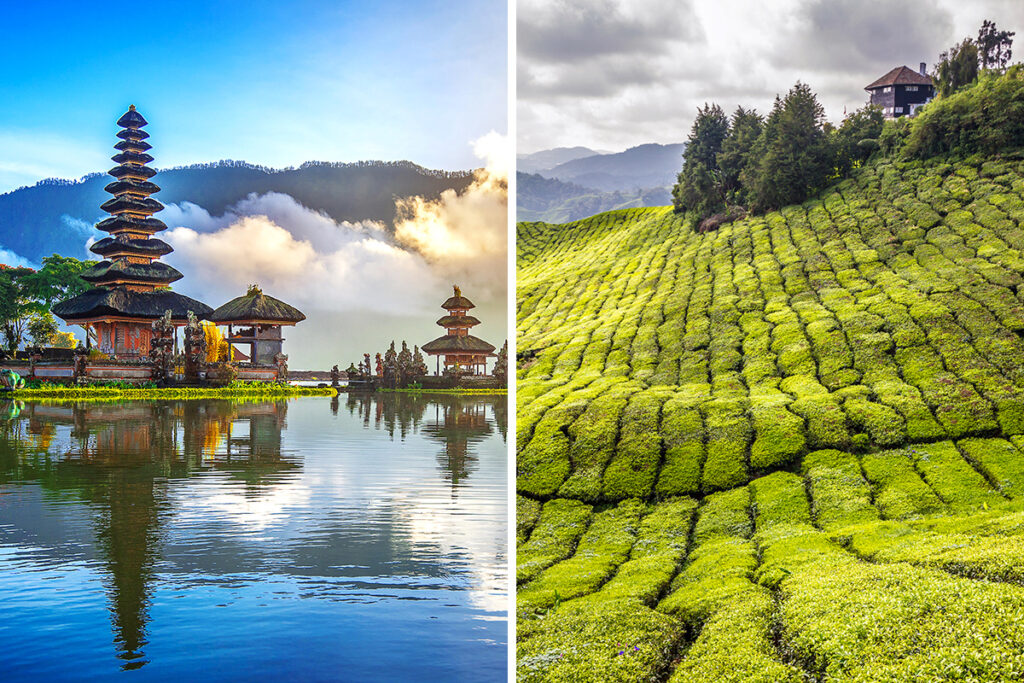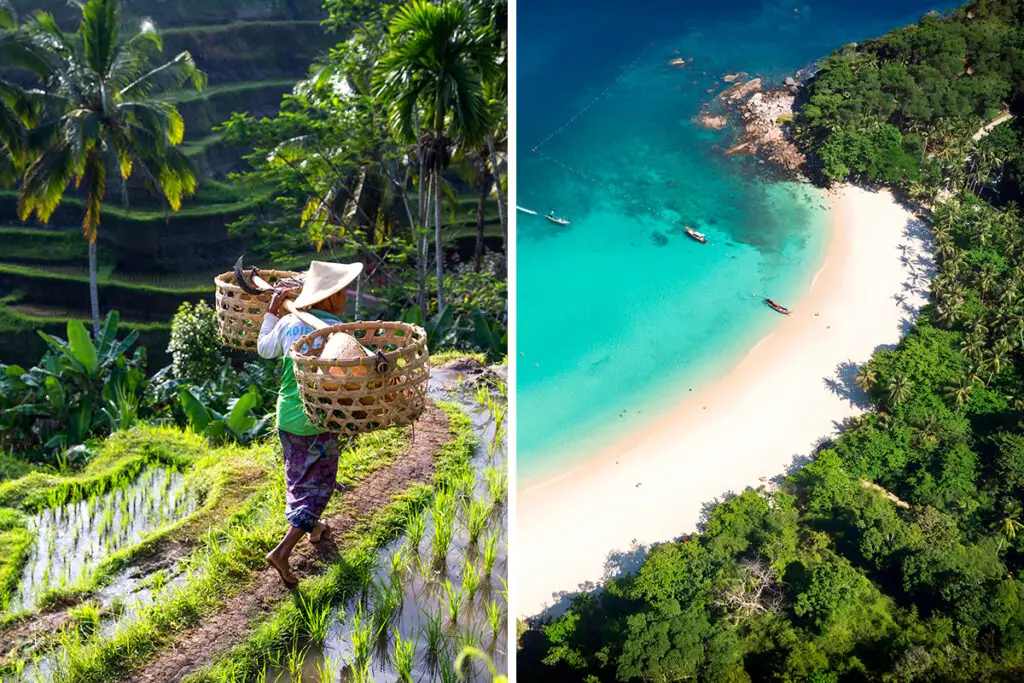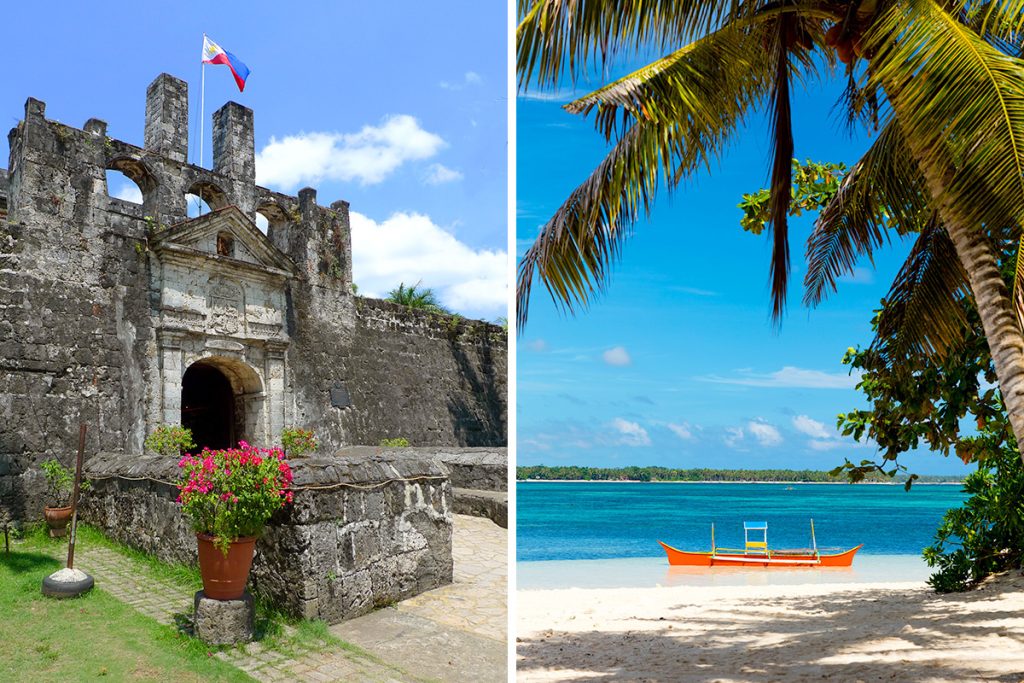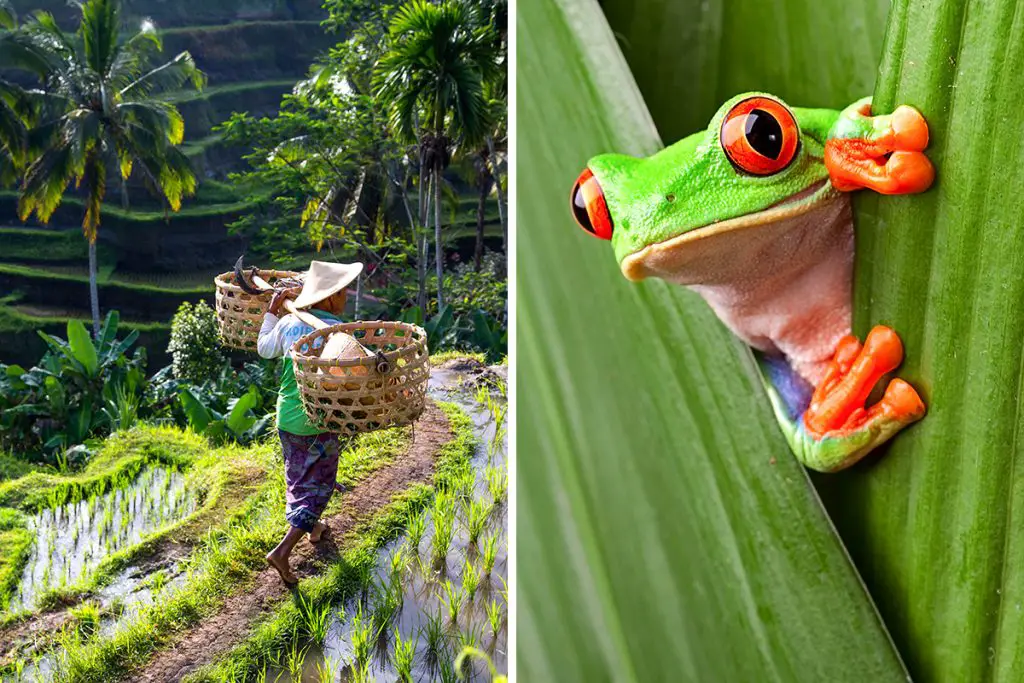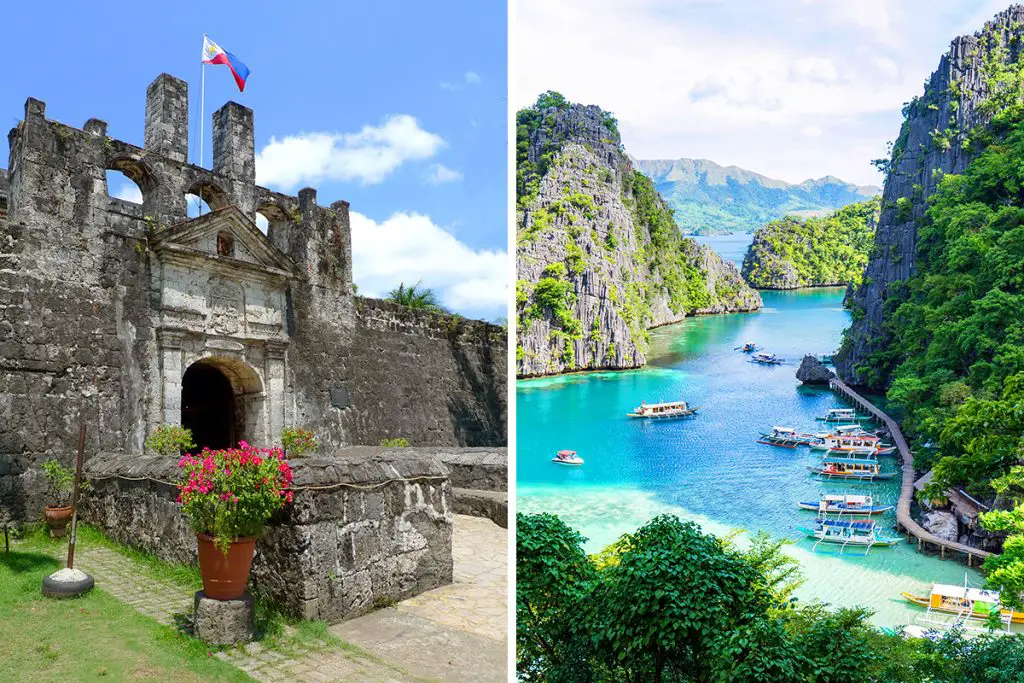With equal parts similar and not, tourists tend to struggle to pick between these gorgeous island nations. And for good reasons. You can expect to have your senses overwhelmed and curiosities satisfied thanks to the eclectic mix of draws each country boasts. Whichever you choose, they’re both the best in Southeast Asia.
Philippines
One of Southeast Asia’s most fascinating and wonderful tourist destinations is the Philippines. The Philippines has a lot to offer intrepid travelers, from vibrant cities to breathtaking beaches and mountains.
More than 7,000 Filipino islands, including the lovely Boracay, Bohol Island, and Cebu, are home to breathtaking landmarks. You will be mesmerized by everything about this location. Expect to see the most alluring tropical beaches in the world. On top of picturesque mountains covered in tropical rainforests.
But the Philippines is more than simply a picture-perfect tropical hideaway. It is more than just for island-hopping trips and beach excursions.
What Makes the Philippines Unique?
7,107 Islands
The Philippines is perhaps one of the most beautiful nations in all of Asia, so you can expect to see an endless array of views and places to hit. With a large collection of 7,107, some even argue it is 7,641, you will never run out of islands and beaches to conquer.
Three of the Philippines’ most famous islands have been awarded by Conde Nast Traveller’s Readers Choice Awards Best Islands in Asia. Siargao, Palawan, and Boracay are all in varying spots in the coveted list, with Siargao in number one. These lists alone tell you about a great many things to expect in many of the nation’s islands.
The Philippines has three main islands or island groups that help further divide and categorize its many islands. Luzon, the northern island, where the capital Manila is found, Visayas, or the central Philippines, and Mindanao, the southern island. Expect to see quite a selection of beaches, underwater features, and even thriving local culture in many of these islands.
Beaches
The beaches in the Philippines are all beautiful, with soft sand and warm winds. But what sets them apart from other beach resorts is a variety of unusual and accessible extras. You’ll see caves, coral, and marine life that are spread out over so many places so close together. For this reason, island-hopping is one of the most popular activities in the Philippines.
The beaches of Luzon, around Batangas and La Union, are known for their millennial vibe and surfing scene. They are mostly accessible to those living in the Metro Manila area.
Visayas’ many smaller islands, where Cebu and Boracay are located, are perhaps the most famous spots in the entire country.
And in Mindanao, there’s the sudden fame of Siargao and many underrated ones around Sarangani and Davao.
Diving Spots
With the many islands, blue water, and white-sand beaches come a wealth of underwater charms as well. The Philippines is perhaps one the best countries to dive in, if not the best. You can certainly find many diving spots in any of the 7,641 (or 7,107) islands
Some of the best ones are:
Coron
Coron Bay is well-known for having the best wreck dives in the Philippines. And that’s on top of stunning limestone cliffs and clear lagoons.
Coron’s ancient World War II shipwrecks are incredibly distinctive. Japanese warships used to dock in Coron Bay during World War II. In September 1944, an aerial assault resulted in the sinking of 11 of these ships. The Coron wrecks now function as reef systems and house a variety of marine species.
Malapascua
The best spot in the world to see thresher sharks is reputed to be Malapascua. The only site in the world where thresher sharks may be routinely spotted daily is this little refuge. That, along with its crystal clear waters and milky white beaches, make it the ideal location for a tropical diving trip.
Deep-sea sharks like threshers spend most of their time submerged. Monad Shoal, a sunken plateau off the southeast coast of Malapascua Island, is home to a large population of cleaner wrasse fish. These fish offer free cleaning services to thresher sharks so they can get rid of parasites and dead tissues from their bodies.
Tubbataha
In Palawan, there is a UNESCO World Heritage Site called Tubbataha Reefs Natural Park. A lot of people concur that Tubbataha is one of the world’s most biodiverse diving locations. It is also the best diving location in the Philippines.
Pure coral reefs, the most diverse marine life in the nation, and pelagic activity. Tubbataha has all of them, big and tiny. You can dive into the Tubbataha Reef and explore the North and South Atolls. These are two enormous coral atolls, as well as the Jessie Beazley Reef, a smaller coral structure northeast of the North Atoll.
A Mix of Cultures
With more than 80 indigenous groups, the culture of the Philippines is extremely diverse. Twenty ethnic states make up the country of the Philippines, and each is capable of fostering its unique languages and cultures. The Philippines will be able to sustain and retain its cultural richness by doing this.
Thanks to its great diversity, while there are similar overtones, each part of the Philippines is different than the others. You can expect them to not only look different but also speak a different language and have a variety of specialty dishes. Many features can also be seen such as embroidery, music style, way of life, to general attitude.
But on top of its over 80 indigenous groups, the Philippines’ colonial past helped further its diversity. The Philippines’ complicated past, reflects the culture there. This was a result of the mixing of indigenous pre-Hispanic Austronesian civilizations.
The cultures of several nations, including Spain, the United States, China, India, and the Arabs, have affected Philippine culture. These nations’ influences can be seen in the many customs that Filipinos still follow today.
Spanish, Catholicism, and other religious events like fiestas were all brought by the Spaniards. They were the archipelago’s first colonizers. The usage of English and the prevalence of modern pop culture are clear indications of American influence. This includes fast food, music, movies, basketball, and media,
The Muslims and their own traditions were brought by the Arabs and Indians to the southernmost island of the Philippines. The Chinese established trade and business in the nation and emphasized the value of family and respect.
The Filipino Hospitality
One should be proud of the hospitality of the Filipino people. People from the Philippines are often recognized for welcoming guests of all races. Whether you are a foreigner or a fellow Filipino, Filipino hospitality knows no boundaries.
And being sensitive to a home guest’s needs knows no boundaries in terms of socioeconomic position. In every Filipino home, if guests drop by unannounced after meals, they can expect to receive some snacks and beverages.
Some families will even go to lengths as serving a little feast or a large celebration whenever a tourist stays in a Filipino home. It is sort of customary for them to prepare abundant Filipino cuisine so that visitors can experience the culture through food.
A happy family would also normally be eager to accommodate and interact with the guests. This is demonstrated not just by providing top-notch service to visitors. This is also extended to their friends, family members, and even strangers.
This aspect of Filipino culture has long been admired by many. This is one reason why locals in the Philippines and tourists from other countries both enjoy traveling. The hospitality of the Filipino people makes the nation’s culture stand out as particularly unique.
The instinct to give guests the best experience possible is something that is never taught to someone. It just comes naturally from within. Rest confident that as soon as you visit, you will receive your fair amount of warmth.
Filipino Food
In the realm of food, Filipino cuisine has recently been dubbed the “next big thing” to watch out for. The result is simple, no-frills food that is simply wonderful. This is thanks to the country’s diversity of influences throughout its long history.
Traditional cooking methods and the Filipinos’ talent for blending flavors are a thing. This makes the most of any ingredients at their disposal.
Food is typically served family-style in big bowls or platters in Filipino houses, and everyone is welcome to help themselves. White rice is always plentiful, and dishes meant to go with it often fill the table’s center and occasionally its edges.
Small bowls of vinegar, fish sauce, bagoong, a fermented seafood sauce or paste, and slices of calamansi, a common citrus fruit. They are typically placed on any available surface to season the cuisine to the preferences of each diner.
In the “kamayan” method of eating, which is used for bigger gatherings, food is placed directly on banana leaves so that everybody can share it.
Here are some of the dishes that define the Philippines:
Adobo
It’s a well-known adobo dish from Filipino cuisine. It is prepared by stewing meat (often chicken, pork, or a combination of the two) in soy sauce and vinegar, along with bay leaves and peppercorns for taste.
Although the word “adobo” comes from the Spanish verb “adobar,” which means “to marinade,” the Spanish did not invent the dish or cooking technique.
It dates back to the pre-Hispanic era when the first Filipinos cooked their chicken and pork. This was done by submerging them in vinegar and salt, perhaps as a way of preservation.
Lechon
Perhaps the well-known Lechon, along with adobo, is one of the best Filipino foods. It is the standard dish served during fiestas (festivals), special occasions, and social events.
It is a spit-roasted pig. Spanish for “roasted piglet,” Lechon really refers to a full-grown roasted pig in the Philippines.
A delectable, fully-roasted pig with flawlessly crisp skin and luscious meat is hard to beat, after all. The best version of this dish can be found on the island of Cebu, but it is usually offered at large Filipino celebrations and fiestas.
Pancit
It describes a group of noodle dishes that are typically cooked with rice noodles, veggies, meat, and seafood. It is said to be inspired by Chinese cuisine. When celebrating someone’s birthday, pancit is typically eaten during celebrations and festivals.
This custom has its roots in the Chinese idea that long life and good health are represented by noodles. Even though pancit is a substantial dinner by itself, it is rarely consumed that way. Rather, it is typically eaten as a side dish with rice and other foods.
Indonesia
It is the largest island country in the world, with more than 17,000 islands, and is located between the Indian and Pacific Oceans. There aren’t many places in the world that can rival Indonesia for diversity among vacationers.
When you think about the size, this shouldn’t be a surprise. At least 17,000 islands make up this country in the middle of Southeast Asia, with 6,000 of them being inhabited.
Indonesia has a wide range of scenery as well. The collection of human beings, civilizations, languages, and faiths is endless. With only one trip, you may almost visit a hundred different nations.
What Makes Indonesia Unique?
The Iconic Bali
Bali is usually cited as the most famous attribute of Indonesia. One of the many islands that make up Indonesia is Bali, which serves as the main tourist hub for the nation. The island is well-known for its volcanoes, yoga retreats, and marine biodiversity.
A private sightseeing trip is a great choice if you want to take your time to see this well-known island. After Julia Roberts visited the mystical island to eat, pray, and love, it gained even more notoriety and is now more well-known than the nation.
Bali is divided into a few unique areas that can accommodate all types of travel. Canggu is the place to go if you enjoy backpacking and are on a tight budget. Visit Seminyak if you enjoy shopping and want to find every modern luxury nearby. And if you want a more laid-back holiday or are more of a free spirit with a passion for the arts, Ubud is the ideal destination for you.
The Tegallalang Rice Terrace, Lempuyang Temple, and Pura Ulun Danu Bratan are among Bali’s most famous locations.
Idyllic Beaches
Islands and beaches abound in Indonesia, and that’s an enormous understatement. Islands and islets make up the entirety of the country, and there are so many of them that it is impossible to accurately count them all. For those who are interested, there are 17,504 islands in all. Only 16,056 of them registered with the UN, though.
Beaches are abundant along with the abundance of islands. One or two may be on the smaller islets, while hundreds may be on the larger ones. It’s difficult to find a country with more beaches than Indonesia.
With its sheer number, you won’t have any trouble locating a beach in Indonesia to lounge on. It can be difficult to decide which to visit since Indonesia is well known for its many cultures. Beach lovers frequently rank Indonesia at the top of their lists of places to visit.
The country boasts an extensive coastline, as well as the high standard and variety of its seaside getaways. Here are some of them:
Seminyak
One of South Bali’s most posh seaside hangouts is Seminyak Beach. The beach features expansive areas of golden sand that are bordered by luxury hotels, outdoor dining options, and beach clubs.
La Plancha is a vibrant beach shack close to Seminyak’s well-known surf break. They offer freshly caught seafood and chilled drinks. Try to score one of the many fantastic beanbag beach chairs there.
Nusa Penida
The collection of beaches in Nusa Penida is unparalleled in all of Indonesia. It is a small, comparatively underdeveloped island immediately south of Bali. To get to the beaches, you might have to descend steep flights of stairs or hike at the base of craggy cliffs. They feel as pure as those you’d find on a deserted island.
On Nusa Penida, there is a beach for every beachgoer. For fantastic photo opportunities, visit the remote Kelingking Beach. There is a famous cliff that resembles an open-mouthed Tyrannosaurus Rex sticking out into the water.
The west-facing Crystal Bay Beach is the best place to see a spectacular sunset. Swimming and snorkeling are also made possible by the calm seas.
For travelers seeking to get off the beaten route in Nusa Penida, Tembeling Beach is a terrific choice. A beautiful forest surrounds the expansive stretch of soft sand and blue water. This provides access to ceremonial grounds with age-old monuments. It also has secret swimming holes and cliff-jumping sites.
Sire
Sire Beach is one of the nicest beaches in Lombok with a vista — with the top of Mt. Rinjani, the second tallest volcano in Indonesia, looming in the distance. The 2.3-mile-long (3.8 kilometers) crescent-shaped shoreline offers visitors panoramic views.
You can see beautiful sunsets with cotton candy clouds. Everything you need to enjoy the sea is available for rent in the beachside rental shops, including canoes and snorkeling gear.
Volcanoes
The volcanoes in Indonesia are well known. They constantly erupt and are almost everywhere. In actuality, there are 147 volcanoes in Indonesia, and 76 of them are currently active. Only Russia and the US have more. But even then, these countries have nothing against the charm and enchantment of Indonesia’s volcanoes.
And if you’re looking for a distinctive volcano, Kawah Ijen has blue flames, which is pretty much an uncommon occurrence. Hot sulfurous gases released by the volcano ignite in the oxygen-rich atmosphere to create an electric blue blaze. The lava burns at night, illuminating the surroundings.
Java
Jakarta, Indonesia’s capital, is located on the island of Java, which is in the middle of Indonesia. It has a long history that dates back to some of the first human endeavors. But in this age of globalization, both locals and visitors can enjoy a variety of activities and attractions there.
Those who enjoy the great outdoors can climb Mount Bromo, a partly dormant volcano that is a popular location to view the dawn or sunset over its crater.
The Largest Muslim Population
Islam is the most common religion in Indonesia, even though many other faiths coexist here. Islam is practiced by more than 87% of the populace. The greatest Muslim population on earth is found in Indonesia. 12% of all Muslims on Earth reside here.
The vast majority of Muslims (98.8%) are Sunni, while a small number of millions (1%), mostly in and around Jakarta, are Shia. Additionally, there are roughly 400,000 (0.2%) Ahmadi Muslims.
On top of the 87% of Indonesians adhering to the Islamic faith, there are other denominations in the nation as well. Around 10% of people identify as Christians. A small percentage of people identify as Hindus (Bali). And indigenous religions predominate in locations like Papua and Borneo.
The rules are not very harsh concerning religious practices. They are aware that there are numerous religions in the nation. Naturally, it’s necessary to dress appropriately if you’re attending a mosque; otherwise, they might not let you in. Respect is still key.
Which Is Better – Indonesia or Philippines?
Nothing beats Indonesia in the Southeast Asian stage when it comes to a jam-packed vacation. It practically has everything that the Philippines can offer and more. Not to mention it’s the cheaper option as well.
Indonesia is often the best starting point in the Southeast Asian vacation experience. It has quirks, natural beauty, and a diverse landscape and culture.
FAQ
Is Indonesia Cheaper Than Philippines?
Despite its more touristy reputation, Indonesia is much cheaper than the Philippines by 4%. The cost of living in Indonesia hits around 564 USD daily, while in the Philippines you can get by with 587 USD.
For the tourist budget, you can get away with around 341 USD daily in Indonesia. While in the Philippines, it may take you around 351 USD daily.
Is Indonesia Richer Than Philippines?
Surpassing the Philippines in both GDP and GDP per capita, Indonesia is richer than the Philippines. In 2021, Indonesia has an annual GDP of 1.1 Trillion USD versus the Philippines’ 394 Billion USD.
The GDP per capita of Indonesia is also significantly higher than the Philippines with 4,356 USD, compared to the latter’s 3,549 USD.
Diving in Philippines vs. Indonesia
When it comes to biodiversity and the sheer amount of beauty, Indonesia is Asia’s best diving destination. Indonesia consists of more than 17,000 islands across 735,000 square miles (1,903,641 square kilometers).
It is bordered by the Indian and Pacific Oceans. This makes it home to quite an array of lesser-known but no less spectacular dive sites in addition to Raja Ampat, Komodo, and Bali.
The immense variety and wealth of marine life found under the seas in Indonesia sets it apart from other Asian dive sites. Over a quarter of all fish species and at least 70% of all coral species call warm seas and tropical reefs home.
The Philippines is also one of the best destinations to dive into in all of Asia. It comes a close second to Indonesia when it comes to biodiversity. However, when it comes to a diverse range of habitats, environments, and even underwater settings, the Philippines is the best in the region.
The protected Tubbataha Reefs National Park in the Philippines is a great place to see a wide variety of marine life. Divers of all skill levels will enjoy diving in Puerto Galera on the island of Mindoro. World-class macro attractions in the Philippines include Anilao and Dumaguete.
Cebu is renowned for its encounters with whale sharks off the coast of Oslob and for the exciting sardine run at Moalboal. Finally, Malapascua Island is located off the northern coast of Cebu. It is one of the few locations in the world where thresher sharks approach the reef.
In addition to all this aquatic life, Coron Bay on Busuanga Island’s eastern side has some of the best wreck diving in Asia.
Are the Philippines Part of Indonesia?
The Philippines sits just north of the islands of Indonesia. They are separate sovereign nations that have quite distinct cultures. Both archipelagos are part of the ASEAN, or the Association of Southeast Asian Nations.
Indonesia to Philippines Distance
There is a 1,083-mile (1,743 kilometers) distance between Indonesia and the Philippines.
Indonesia Philippines Time Difference
With different time zones, the Philippines is one hour ahead of Indonesia.
Indonesia vs. Philippines Culture
Despite being close neighbors, Indonesia and the Philippines have stark differences. To point out which is better would be disrespectful. The key difference in their culture however mostly lies in their religion, general attitude, and history.
The Philippines is mostly made up of Roman Catholics and a smaller percentage of Islam. While in Indonesia, it is the complete opposite. It has, in fact, the largest concentration of Muslims in the world.
Despite being colonized by the Dutch before, traces of the influence are hard to notice in Indonesia. Whereas in the Philippines, the Spanish, Japanese, Chinese, and American influences are apparent. Plus, Filipinos are more liberal and westernized than Indonesians.
Indonesia vs. Philippines Language
Both Indonesia and Philippines’ languages come from the Austronesian Language Family. There are many similar words, but the differences are staggering. Despite similar roots, the languages of the Philippines and Indonesia aren’t mutually intelligible —
Indonesian languages such as Javanese, Sundanese, and Balinese are considered to be difficult languages to learn. The Philippine languages including Tagalog, Cebuano, and Hiligaynon are also complex to learn.
Indonesia to Philippines Travel Time
The typical travel time by plane from Indonesia to the Philippines is around four hours.
Boat From Philippines to Indonesia
You can’t get a boat from the Philippines to Indonesia.
Indonesia to Philippines Ferry
There are no ferry services that will take you from Indonesia to the Philippines, directly.
Indonesia to Philippines Travel Time by Ship
If there were aquatic transport services between them, the travel time will most likely take around two to three days.


